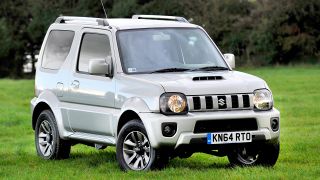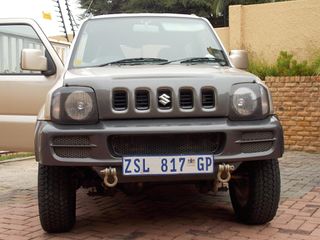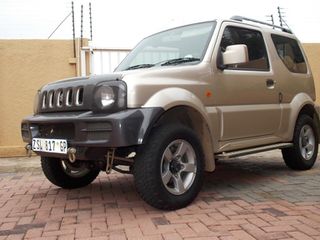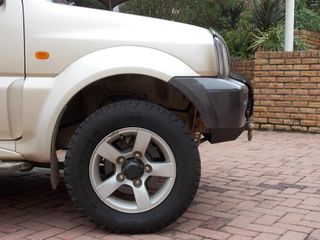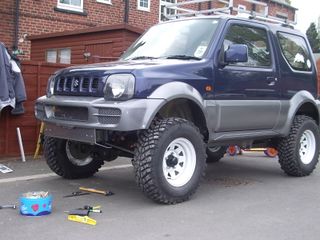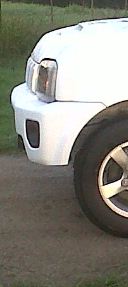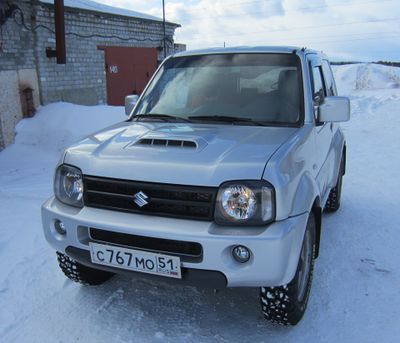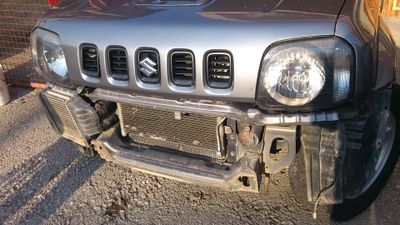Difference between revisions of "Front bumper issues"
(Additional cleanup) |
(Additional notes in the swap chapter) |
||
| (One intermediate revision by the same user not shown) | |||
| Line 84: | Line 84: | ||
** However, the difference is not so pronounced as with a change from 2nd model to 1st model front bumper. | ** However, the difference is not so pronounced as with a change from 2nd model to 1st model front bumper. | ||
| − | |||
| − | |||
| − | |||
* Replacing one model of a front bumper with another on the same vehicle should be legal (both are genuine parts), and it should not affect the operation of the airbag sensor(s). | * Replacing one model of a front bumper with another on the same vehicle should be legal (both are genuine parts), and it should not affect the operation of the airbag sensor(s). | ||
** But this is a theoretical assumption. | ** But this is a theoretical assumption. | ||
| Line 99: | Line 96: | ||
* The side view picture of a 3rd model front bumper might not be directly comparable with these two on the left, because it was '''not''' taken from the exactly the same angle. | * The side view picture of a 3rd model front bumper might not be directly comparable with these two on the left, because it was '''not''' taken from the exactly the same angle. | ||
<br clear=all> | <br clear=all> | ||
| + | |||
| + | |||
| + | ==== Issues with bumper to vehicle attachment points ==== | ||
| + | |||
| + | |||
| + | * There are slight differences in the mounts for attaching a front bumper on the vehicle, especially on Jimnys 3 produced before and after 2012. | ||
| + | ** The points of attachment of the bumper to the body should all be the same on any Jimny 3. | ||
| + | ** However, the points of attachment of the bumper to the chassis are slightly different for each front bumper generation. | ||
| + | ** Also, the top side of 3rd model front bumper has some additional mounting holes for the front "hummer type" front grille, which the older bumper models do not have. | ||
| + | *** These holes can be easily cut in the older bumper models if needed. | ||
| + | |||
| + | |||
| + | * There are metal brackets factory welded onto the front end of chassis rails. | ||
| + | * These brackets serve both as impact dampers and as mounting points for a front bumper to the chassis. | ||
| + | * There are three distinct types / shapes of these brackets for petrol Jimnys 3 - for three front bumper models: | ||
| + | *# 1st "petrol" bracket model - P.N. <font face="Courier">57153-81A00</font> - used on petrol Jimnys 3 with 1st front bumper model; | ||
| + | *#* Two are used per vehicle; | ||
| + | *# 2nd "petrol" bracket model - P.N. <font face="Courier">57153-76J00</font> - used on petrol Jimnys 3 with 2nd front bumper model; | ||
| + | *#* Two are used per vehicle; | ||
| + | *# 3rd "petrol" bracket model - P.N. <font face="Courier">57153-57M00</font> - used on petrol Jimnys 3 with 3rd front bumper model; | ||
| + | *#* Two are used per vehicle; | ||
| + | * There are also two distinct types / shapes of these brackets for diesel (DDiS) Jimnys 3 - for two bumper models: | ||
| + | *# 1st "diesel" bracket model - P.N. <font face="Courier">57210-84A00</font> - used on DDiS Jimnys 3 with 1st bumper model; | ||
| + | *# 2nd "diesel" bracket model - P.N. <font face="Courier">57210-84A11</font> - used on DDiS Jimnys 3 with 2nd bumper model; | ||
| + | ** Both "diesel" brackets are ''completely'' different from any of the "petrol" brackets. | ||
| + | ** Diesel brackets much larger and are actually integrated with the front crossmember, so the above two part numbers actually represent the entire front crossmember (only one needed per vehicle). | ||
| + | * Surprisingly, Suzuki offers each of the above listed items as a separably obtainable spare part. | ||
| + | ** Therefore, any current/old "petrol" bracket can be easily cut off from the chassis rail (the welded surface area between them is rather small) and a new bracket can easily be welded in its place, with minor follow-up rust proofing performed. | ||
| + | ** The replacement of "diesel" brackets is more complicated as more cutting and welding is involved - an entire chassis crossmember is being replaced! | ||
| + | |||
| + | |||
| + | * If you attempt to mount a front bumper model which was not meant for your Jimny 3, the bumper attachment points to the brackets on the front ends of chassis rails will be misaligned. | ||
| + | ** Therefore, you will either have to fabricate some additional brackets between the current brackets and the bumper, or to replace the current front chassis rail end brackets with suitable ones from the list above. | ||
| + | * Additionally, the 3rd petrol bracket model collides with the bottom end (plastic skid plate) of the 1st front bumper model, because the bracket hangs too low toward the ground in this case. | ||
| + | ** Therefore, there are three solutions to use 1st front bumper model on a post-2012 Jimny 3 with 3rd bracket model: | ||
| + | **# Discard the bottom of the 1st model front bumper (its black skid plate); | ||
| + | **# Cut off the lower half of those brackets; | ||
| + | **# Replace the entire brackets with suitable brackets for 1st model front bumper; | ||
| + | *** Note: In the first two solutions, you will still have to fabricate a pair of additional "re-alignment" brackets to sit between the OEM brackets and the 1st front bumper model. | ||
Latest revision as of 07:11, 29 November 2019
![]() The content of any article might be expanded / improved in the future - revisit it sometimes.
The content of any article might be expanded / improved in the future - revisit it sometimes.
![]() Seen a mistake? Know something that isn't written? Edit and change this article yourself!
Seen a mistake? Know something that isn't written? Edit and change this article yourself!
![]() Some images in the article (if present) can be enlarged by clicking on them.
Some images in the article (if present) can be enlarged by clicking on them.
Contents
Introduction
Jimnys 3 were produced from 1998 to 2018, and there have been three front bumper models / editions on them:
- 1st model bumper (1998-2006)
- 2nd model bumper (2006-2012)
- 3rd model bumper (2012-2018)
All of those are made of plastic.
Main characteristics of each bumper model / edition:
- The 1st model bumper is the smallest one (does not hang too low to the ground).
- The 3rd model bumper also is not bad.
- However, 2nd model bumper is overly large (hangs very low to the ground), and it significantly reduces the approach angle.
- The risk of it hitting the ground is quite higher than with other two bumper models.
Problems with 2nd model front bumper
- The 2nd model front bumper is the most endangered point when off-roading, and it's easy to damage.
- Also, 2nd model bumper reduces the space around the front wheels, limiting the size to which the wheels can be increased (by using larger tyres).
- With 2nd model bumper, the usual tyre size limit is 205 / 75 / R15 (and even that size sometimes makes a contact if the bumper is sagged).
- On the other hand, with the 1st model bumper, even 215 / 75 / R15 is usually not a problem.
The 3rd model front bumper is also a bit restrictive in regards to the above issues, but not as much as the 2nd model front bumper.
Solution 1: Trimming the front bumper
- Trimming the lower part of a front bumper is the quickest and (seemingly) the simplest solution to increasing vehicle's approach angle and free space around front wheels.
- Because of all the mentioned problems with the 2nd model front bumper, many people trim the bottom half of the 2nd model front bumper, but it tends to look ugly.
- Also, if you trim a 2nd model or 3rd model front bumper, you would probably lose your front fog lamps (if you have them) and a place to hold the front license plate.
Alternative solution to trimming a front bumper is to replace it with something else.
Examples of trimmed 2nd model front bumpers
- Example 1 of trimmed 2nd model front bumper
- Example 2 of trimmed 2nd model front bumper
- Notice that the resulting trimmed 2nd model front bumper (in both examples) is actually only slightly shallower than a stock (unmodified) 1st model front bumper.
- Some people trim the 1st model front bumper as well.
- However, if you really need such high approach angles, then your vehicle is probably already so much modified that one more ugly trim does not matter for the aesthetics or fog lamp / license plate functionality.
Solution 2: Factory bumper model swap
Main idea
- If you have a 2nd model front bumper, and you find that it obstructs your vehicle's off-roading "potency" (or limits your intentions on using larger tyres), the best alternative is to buy a second-hand 1st model front bumper (1998-2006) from a scrap yard (or exchange it with another Jimny owner), paint it if needed, and install it instead of the 2nd model front bumper.
- You could even swap a 3rd model front bumper with a 1st model front bumper if you want some more clearance.
- However, the difference is not so pronounced as with a change from 2nd model to 1st model front bumper.
- Replacing one model of a front bumper with another on the same vehicle should be legal (both are genuine parts), and it should not affect the operation of the airbag sensor(s).
- But this is a theoretical assumption.
- Here is a side-by-side comparison of 1st and 2nd model front bumper on the same vehicle.
- The body color differs in the left and right parts of the image because of different lightning conditions.
- The "before" (left) part of the image is with a 2nd model bumper.
- The "after" (right) part of the image is with a 1st model bumper.
- The side view picture of a 3rd model front bumper might not be directly comparable with these two on the left, because it was not taken from the exactly the same angle.
Issues with bumper to vehicle attachment points
- There are slight differences in the mounts for attaching a front bumper on the vehicle, especially on Jimnys 3 produced before and after 2012.
- The points of attachment of the bumper to the body should all be the same on any Jimny 3.
- However, the points of attachment of the bumper to the chassis are slightly different for each front bumper generation.
- Also, the top side of 3rd model front bumper has some additional mounting holes for the front "hummer type" front grille, which the older bumper models do not have.
- These holes can be easily cut in the older bumper models if needed.
- There are metal brackets factory welded onto the front end of chassis rails.
- These brackets serve both as impact dampers and as mounting points for a front bumper to the chassis.
- There are three distinct types / shapes of these brackets for petrol Jimnys 3 - for three front bumper models:
- 1st "petrol" bracket model - P.N. 57153-81A00 - used on petrol Jimnys 3 with 1st front bumper model;
- Two are used per vehicle;
- 2nd "petrol" bracket model - P.N. 57153-76J00 - used on petrol Jimnys 3 with 2nd front bumper model;
- Two are used per vehicle;
- 3rd "petrol" bracket model - P.N. 57153-57M00 - used on petrol Jimnys 3 with 3rd front bumper model;
- Two are used per vehicle;
- 1st "petrol" bracket model - P.N. 57153-81A00 - used on petrol Jimnys 3 with 1st front bumper model;
- There are also two distinct types / shapes of these brackets for diesel (DDiS) Jimnys 3 - for two bumper models:
- 1st "diesel" bracket model - P.N. 57210-84A00 - used on DDiS Jimnys 3 with 1st bumper model;
- 2nd "diesel" bracket model - P.N. 57210-84A11 - used on DDiS Jimnys 3 with 2nd bumper model;
- Both "diesel" brackets are completely different from any of the "petrol" brackets.
- Diesel brackets much larger and are actually integrated with the front crossmember, so the above two part numbers actually represent the entire front crossmember (only one needed per vehicle).
- Surprisingly, Suzuki offers each of the above listed items as a separably obtainable spare part.
- Therefore, any current/old "petrol" bracket can be easily cut off from the chassis rail (the welded surface area between them is rather small) and a new bracket can easily be welded in its place, with minor follow-up rust proofing performed.
- The replacement of "diesel" brackets is more complicated as more cutting and welding is involved - an entire chassis crossmember is being replaced!
- If you attempt to mount a front bumper model which was not meant for your Jimny 3, the bumper attachment points to the brackets on the front ends of chassis rails will be misaligned.
- Therefore, you will either have to fabricate some additional brackets between the current brackets and the bumper, or to replace the current front chassis rail end brackets with suitable ones from the list above.
- Additionally, the 3rd petrol bracket model collides with the bottom end (plastic skid plate) of the 1st front bumper model, because the bracket hangs too low toward the ground in this case.
- Therefore, there are three solutions to use 1st front bumper model on a post-2012 Jimny 3 with 3rd bracket model:
- Discard the bottom of the 1st model front bumper (its black skid plate);
- Cut off the lower half of those brackets;
- Replace the entire brackets with suitable brackets for 1st model front bumper;
- Note: In the first two solutions, you will still have to fabricate a pair of additional "re-alignment" brackets to sit between the OEM brackets and the 1st front bumper model.
- Therefore, there are three solutions to use 1st front bumper model on a post-2012 Jimny 3 with 3rd bracket model:
Example pictures of swapped bumpers
Pre-2013 and post-2013 Jimnys 3 have different front bonnet and grille (look at the pictures in the "Introduction" chapter):
- In pre-2013 Jimnys, the bonnet and grille are a single-piece and there are five plastic grille holes / grids in the bonnet itself
- In post-2013 Jimnys, the bonnet is shorter in the front, and there is a large fixed front grille between the front head lamps, reminiscent of a "Hummer-style" front grille.
The picture galleries below show how it looks like when a 1st and 2nd model front bumper are paired with a post-2013 Jimny, and also when a 3rd model front bumper is paired with a post-2013 Jimny.
It appears that it is not trivial to fit a 1st model front bumper to a Jimny 3 which originally had a 3rd model front bumper. Some parts of the chassis collide with the older bumper, and there are no mounting holes in the top of the old bumper for the center grille (between the head lamps).
However, the swap is still possible after some modifications, as shown in this Russian's report.
Additional considerations
Front fog lamps
If you already have front fog lamps in your current/old front bumper, and want to continue having front fog lamps in the new front bumper, the possible solutions depend on which front bumper models you are swapping.
![]() The wiki article "Front fog lamps" contains all the details about front fog lamps.
The wiki article "Front fog lamps" contains all the details about front fog lamps.
If replacing 1st model front bumper with 2nd model front bumper:
- By the way, why would you want to do this?
- Jimnys with factory installed 1st model front bumper used three types of front fog lamps:
- The oldest ones which do not have a bezel around them (P.N. 35500-74F50);
- Neither these front fog lamps nor their carriers/brackets will be compatible with the new bumper.
- In other words, you will have to obtain an entire new set of front fog lamps (including carriers) which match the new front bumper model.
- Neither these front fog lamps nor their carriers/brackets will be compatible with the new bumper.
- The middle ones which have a bezel around them (produced by Cibie, model 026719), which have a surrounding bezel as a separate part;
- Neither these front fog lamps nor their carriers/brackets will be compatible with the new bumper.
- In other words, you will have to obtain an entire new set of front fog lamps (including carriers) which match the new front bumper model.
- Neither these front fog lamps nor their carriers/brackets will be compatible with the new bumper.
- The newest ones (P.N. 35500-63J00 or 35500-63J02 or 35500-63J04), which usually have a surrounding bezel as a separate part.
- These front fog lamps will be compatible with the new bumper, but their carriers/brackets will not.
- You will have to obtain other type of front fog lamp carriers which match the new front bumper model, but you can reuse the fog lamps.
- These front fog lamps will be compatible with the new bumper, but their carriers/brackets will not.
- The oldest ones which do not have a bezel around them (P.N. 35500-74F50);
If replacing 1st model front bumper with 3rd model front bumper:
- Jimnys with factory installed 1st model front bumper used three types of front fog lamps:
- The oldest ones which do not have a bezel around them (P.N. 35500-74F50);
- Neither these front fog lamps nor their carriers/brackets will be compatible with the new bumper.
- In other words, you will have to obtain an entire new set of front fog lamps (including carriers) which match the new front bumper model.
- Neither these front fog lamps nor their carriers/brackets will be compatible with the new bumper.
- The middle ones which have a bezel around them (produced by Cibie, model 026719), which have a surrounding bezel as a separate part;
- Neither these front fog lamps nor their carriers/brackets will be compatible with the new bumper.
- In other words, you will have to obtain an entire new set of front fog lamps (including carriers) which match the new front bumper model.
- Neither these front fog lamps nor their carriers/brackets will be compatible with the new bumper.
- The newest ones (P.N. 35500-63J00 or 35500-63J02 or 35500-63J04), which usually have a surrounding bezel as a separate part.
- These front fog lamps will be compatible with the new bumper without a need for any carrier in between (they bolt on directly to the bumper).
- The fog lamp carriers from the old bumper will be surplus and can be sold to someone else.
- The oldest ones which do not have a bezel around them (P.N. 35500-74F50);
If replacing 2nd model front bumper with 1st model front bumper:
- The current front fog lamps will be compatible with the new bumper, but their carriers/brackets will not.
- You will have to obtain another type of front fog lamp carriers which is compatible with the new bumper.
If replacing 2nd model front bumper with 3rd model front bumper:
- The current front fog lamps will be fully compatible with the new bumper.
- As the 3rd model front bumper has integrated front fog lamp carriers/brackets, the current front fog lamp carriers from the 2nd model front bumper will become surplus.
If replacing 3rd model front bumper with 1st model front bumper:
- The current front fog lamps will be compatible with the new bumper.
- The current bumper has integrated carriers which are not separable anyway.
- You will have to obtain suitable front fog lamp carriers which are compatible with the new bumper.
If replacing 3rd model front bumper with 2nd model front bumper:
- By the way, why would you want to do this?
- The current front fog lamps will be fully compatible with the new front bumper.
- However, you will need to obtain a pair (left+right) of matching front fog lamp carriers for the 2nd model front bumper.
Inner front wheel arches
- Inner front wheel arches (black plastic arches) have different length for different bumper models.
- Your current ones will either be too short with the new bumper, or you will have to shorten them (depending on what you are replacing with what).
- If you are swapping a 2nd model front bumper with a 3rd model or 1st model front bumper (or a 3rd model front bumper with a 1st model front bumper), your old inner front wheel arches will be too long for the new bumper.
- The simplest remedy is to trim the front bottom part of the inner wheel arches.
- However, it would be more advisable to buy the matching front inner wheel arches together with the new front bumper.
- This leaves your old front inner wheel arches intact for future use or for selling.
- The simplest remedy is to trim the front bottom part of the inner wheel arches.
- On the other hand, if you are (for some impractical reason) replacing your 1st model front bumper with a 2nd model or 3rd model front bumper (or a 3rd model front bumper with a 2nd model front bumper), then you will have to buy the matching front inner wheel arches, because your old ones will be too short.
Front nudge bar (bull bar)
- If your vehicle currently has a metal front nudge bar (bull bar) installed, it probably will not be compatible with a different bumper model.
- If you are swapping a 2nd model front bumper with a 3rd model or 1st model front bumper (or a 3rd model front bumper with a 1st model front bumper), the old nudge bar will fit without any collisions, but its bottom will be too low compared with the bottom of the new bumper.
- On the other hand, if you are (for some impractical reason) replacing your 1st model front bumper with a 2nd model or 3rd model front bumper (or a 3rd model front bumper with a 2nd model front bumper), the bottom of the old nudge bar will most probably collide with the bottom of the new front bumper, because the new front bumper hangs lower towards the ground.
![]() Front nudge bars severely restrict vehicle's approach angle, so they should preferably be removed altogether if the vehicle is used in off road duty. Read more in the wiki article "Bull bar (nudge bar)".
Front nudge bars severely restrict vehicle's approach angle, so they should preferably be removed altogether if the vehicle is used in off road duty. Read more in the wiki article "Bull bar (nudge bar)".
Restrictions with DDiS Jimnys
It has been confirmed that replacing a 2nd model front bumper with a 1st model front bumper is not practical on DDiS (diesel) Jimnys with 63kW (intercooled) K9K 266 engine.
- The problem is that the engine intercooler sits low right up front, just above the right fog lamp.
- If you try to replace the factory-installed 2nd model front bumper with the 1st model front bumper, you will have to discard the right fog lamp (if you have fog lamps).
- You will also have to leave open the right fog lamp hole in the 1st model bumper, in order to feed the intercooler with air.
- Even that hole might not be sufficient to feed it with enough air.
- You should also install some grid in the right fog lamp hole, to prevent an object going through the hole and puncturing the intercooler.
- You will also have to leave open the right fog lamp hole in the 1st model bumper, in order to feed the intercooler with air.
- Alternatively, you could dislocate the intercooler, but the free space in the engine bay is very scarce, and moving the intercooler is an expensive modification on itself.
- Jimny 3 DDiS edition 2 without the front bumper
Replacing a 2nd model front bumper with a 3rd model front bumper on a DDiS Jimny with 63kW (intercooled) K9K engine would also probably incur the same above issues, but this combination has not yet been tried in practice.
Solution 3: Heavy-duty metal "off roader" ("winch") front bumper
Another alternative to all these factory bumper model swaps or trimmings is to buy an aftermarket heavy-duty metal "off roader" front bumper (also called a "winch bumper").
Advantages of a heavy-duty metal front bumper:
- Prominent looks;
- Takes a beating off road;
- Typically increases the approach angle;
- It can also be used as a mount for driving lamps, winch, high lift jack, machine gun, a statue from the front of a ship, etc.
- You have a right to declare one gear as "ramming speed";
However, metal front bumpers have the following disadvantages:
- They might not be legal in certain regions;
- They increase the weight of the front of the car, possibly sagging the front suspension and increasing its wear;
- They might restrict airflow to the engine cooling system, and to the intercooler (if fitted);
- If they stick too far out to the front, they might actually reduce the approach angle;
- Most metal front bumpers will adversely affect the operation of the airbag sensor(s);
- Most metal front bumpers will adversely impact the fate of anything that collides with them;
![]() If you have a traffic accident while driving a vehicle which has an illegal front bumper fitted (no matter if the accident is your fault or not), you could face severe government penalties + lawsuits from other participants in the accident (for example, from a pedestrian or a child's furious parents whose bones your fancy bumper broke)!
If you have a traffic accident while driving a vehicle which has an illegal front bumper fitted (no matter if the accident is your fault or not), you could face severe government penalties + lawsuits from other participants in the accident (for example, from a pedestrian or a child's furious parents whose bones your fancy bumper broke)!
Front bull bars (nudge bars)
These are accessory items which are (technically) not directly related to front bumpers.
Therefore, they have their dedicated wiki article: "Bull bar (nudge bar)".
Page last edited on 29/11/2019 by user Bosanek


